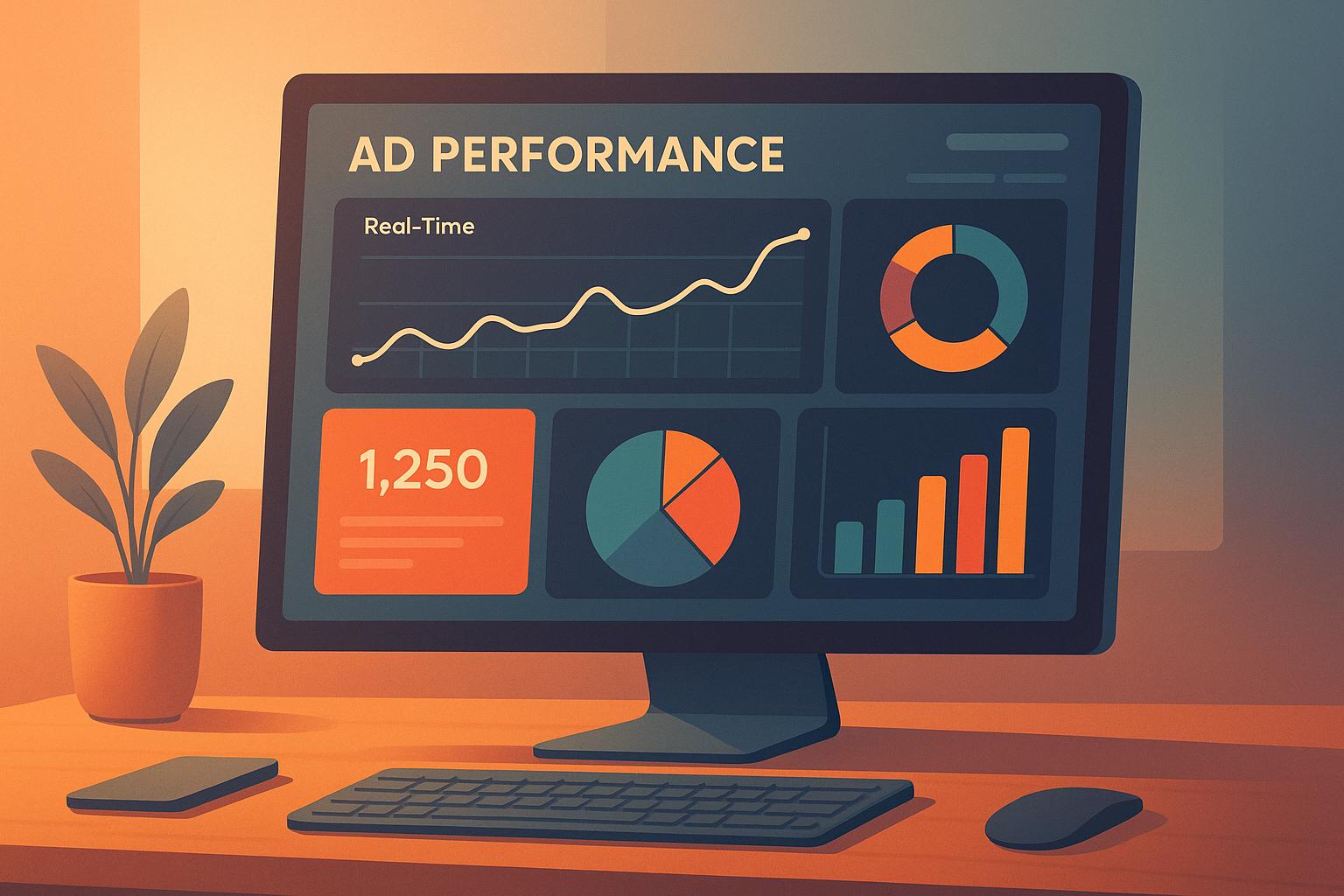


Real-time ad performance tracking is vital for optimizing campaigns, ensuring budget efficiency, and making quick adjustments for better results.
Tracking ad performance in real time is no longer optional - it's essential for making quick, informed decisions and optimizing ad spend. By monitoring campaigns as they happen, you can adjust strategies immediately, scale successful ads, and cut losses on underperforming ones. This is especially critical for time-sensitive campaigns like product launches or events.
Here’s what you need to know:
- What It Is: Real-time tracking provides instant access to metrics like click-through rates (CTR), cost per acquisition (CPA), and return on ad spend (ROAS).
- Why It Matters: Delayed data can lead to wasted budgets. Real-time insights let you act fast, especially when targeting niche audiences like developers.
- How to Set It Up: Use tools with real-time data access, automate data workflows, and ensure consistent reporting standards. Platforms like daily.dev Ads help advertisers target developers effectively with instant performance data.
- Key Metrics: Focus on CTR, CPA, ROAS, engagement rates, and impression share to evaluate and optimize campaigns.
The right tools and practices ensure your campaigns stay efficient and effective, saving time and money while improving results.
RedTrack.io Teaser: The Ultimate Ad Tracking, Attribution & Automation Tool for Media Buyers
Setting Up Real-Time Tracking Infrastructure
Start by choosing tools that provide real-time data access to make immediate campaign adjustments. Once you have the right tools, connect your analytics and automate data flows to ensure smooth, uninterrupted tracking.
Connecting Analytics and Tracking Tools
Pick an ad platform that offers built-in real-time tracking. For instance, daily.dev’s self-serve platform provides instant campaign data, making it easy to integrate with other analytics tools for a streamlined experience.
Automating Data Flows
Use APIs and workflows to automate data transfers. This not only removes delays but also reduces errors, giving your team more time to focus on refining strategies rather than managing data manually.
Setting Up Accurate Reporting Standards
Establish consistent reporting standards across all data sources. For example, use U.S. dollars ($) and align time zones for clear, unified reporting. Daily.dev’s self-serve platform supports these needs by delivering precise, real-time data tailored for developer-focused campaigns.
Key Metrics and Data Points to Monitor
Keeping an eye on key metrics in real time allows you to make quick adjustments to campaigns and safeguard your budget. With daily.dev's instant performance data, this becomes a seamless process.
Core Metrics for Campaign Evaluation
Click-through rate (CTR) shows how relevant your ads are to your audience. For developers, consistently tracking CTR helps pinpoint when adjustments to creative elements or targeting strategies are needed.
Cost per acquisition (CPA) is crucial for understanding the cost-effectiveness of your campaign. Calculate CPA by dividing your total ad spend by the number of conversions. Monitoring this ensures your campaign stays within budget while delivering results.
Return on ad spend (ROAS) gives you a clear picture of the revenue generated for every dollar spent. Connecting conversion tracking with revenue data helps identify the audience segments and creative approaches that yield the best returns.
Engagement rates go beyond clicks, offering insight into how developers interact with your content. Metrics like time spent on landing pages, scroll depth, and actions such as resource downloads or demo sign-ups provide a deeper understanding of campaign performance.
Impression share reflects how often your ads appear compared to the total opportunities available. A low impression share might indicate budget constraints or overly narrow targeting, which is especially relevant for daily.dev's audience of over 1 million developers.
Balancing these immediate metrics with a focus on long-term trends is essential for refining your overall strategy.
Balancing Short-Term and Long-Term Data
Real-time data provides instant feedback, while long-term trends uncover patterns that shape strategic decisions. Short-term shifts often highlight timing or platform-specific factors. For instance, usage patterns among daily.dev's 40% power users can help explain sudden changes in performance.
Prioritize metrics that directly impact spending. If CPA rises sharply, review your targeting, ad placements, or landing page performance. Similarly, if engagement rates fluctuate, observe the broader trend before making creative changes.
Over time, segmenting performance data by factors such as developer seniority, preferred programming languages, or tools can guide campaign planning and budget allocation. This approach ensures your metrics capture both the quantity and quality of engagement, allowing for smarter, data-driven adjustments that strengthen your real-time tracking strategy.
sbb-itb-e54ba74
Best Practices for Real-Time Monitoring and Optimization
Start tracking your campaign even before it goes live, and use real-time data to fine-tune your strategies as it progresses.
Pre-Campaign Setup
- Define your audience on daily.dev using specific criteria such as seniority levels (Aspiring, Entry-Level, Mid-Level, Senior Engineers), programming languages (e.g., JavaScript, Python, Java, Swift, Go), and developer tools (like Docker, Kubernetes, Jenkins, Jupyter Notebook, Visual Studio Code).
- Select ad placements that align with your campaign goals. Daily.dev provides hyper-native ad options, including In-Feed Native Ads, Post Page Ads, and Personalized Digest Ads, all designed to boost visibility and engagement.
- Establish clear, measurable objectives - whether it's driving product adoption, increasing brand awareness, boosting event attendance, generating qualified leads, growing website traffic, or launching a product. These benchmarks will help gauge your campaign's success.
- Ensure your budget meets the minimum spend of $5,000 on daily.dev. This amount is essential for gathering enough data to make informed, real-time decisions.
Once your campaign is live, shift your focus to ongoing evaluation and quick adjustments.
Ongoing Monitoring and Adjustments
- Use daily.dev's real-time tracking tools to regularly review campaign performance. Monitor for trends or irregularities, and make adjustments swiftly to keep your campaign on track.
Maintaining Data Accuracy and Integrity
Reliable data is the backbone of real-time ad tracking. Errors or inconsistencies can lead to poor decisions and wasted ad budgets. Ensuring data accuracy is essential for making the quick adjustments we’ve previously discussed.
Auditing Data Sources
Regularly auditing your data sources is key to maintaining consistency across platforms. If you notice unusual spikes or dips in metrics, take the time to investigate. These anomalies could point to technical issues that need immediate attention. Setting up automated alerts for anomalies can save time and catch problems early. Tools like Daily.dev’s real-time performance tracking for self-serve ad campaigns make it easier to identify and address such issues. These audits play a vital role in supporting continuous, real-time adjustments.
Using UTM Parameters and Identifiers
UTM parameters are essential for precise campaign attribution. They ensure that every interaction is tracked and attributed correctly. To keep things organized, establish a clear UTM naming convention, such as source_medium_campaign_date. Always include the five core UTM parameters: utm_source, utm_medium, utm_campaign, utm_term, and utm_content. For example, a campaign targeting developers on Daily.dev might use values like utm_source=dailydev and utm_medium=native_ad. Keep a centralized record of your UTM tags and routinely test tagged URLs to avoid duplicates and ensure your analytics remain accurate.
Following Privacy Regulations
Adhering to privacy regulations is not just a legal necessity - it’s also a way to build trust with your audience. For instance, Daily.dev uses cookies to enhance user experience and requires users to agree to its Privacy Policy and Terms of Service before continuing to use the site. Their approach is clearly stated:
"We value your privacy. This site uses cookies to improve your experience. By continuing to use our site, you accept our use of cookies, Privacy Policy, and Terms of Service."
When running ad campaigns on platforms like Daily.dev, make sure your data collection practices align with their privacy policies. Implement transparent consent management systems to explain what data is collected and how it will be used. Regularly review your privacy practices to comply with regulations like the CCPA and GDPR. Additionally, establish clear data retention policies to balance compliance with the need for historical data in performance analysis. Following these practices not only ensures compliance but also strengthens the foundation for real-time campaign optimization.
Summary of Best Practices
Let’s pull together the key takeaways from the setup, monitoring, and data integrity practices discussed earlier. Real-time tracking transforms your approach from simply reacting to issues into actively improving performance as it happens. To start, choose an advertising platform that supports real-time monitoring right out of the gate. For instance, the Self-Serve option from daily.dev Ads includes built-in tools for tracking performance in real time. This kind of foundation strengthens every other best practice you apply throughout your campaign.
A solid infrastructure is crucial. This means connecting analytics tools, automating data workflows, and standardizing reporting processes so you can quickly identify and resolve problems. Using clear UTM parameter conventions and keeping centralized documentation also boosts teamwork and ensures everyone stays on the same page.
Targeting the right audience is another critical factor. Effective audience targeting doesn’t just improve engagement - it also makes your tracking efforts more accurate. With daily.dev Ads, you can target users based on developer seniority, programming languages, and tools, which helps ensure your performance metrics reflect genuine audience interaction. This level of precision allows for smarter, real-time adjustments.
When it comes to monitoring, balance is key. Combine automated alerts with strong team collaboration and maintain clear documentation. Also, define your core metrics early on to stay focused on what matters most.
Finally, regular audits, consistent use of UTM parameters, and adherence to privacy regulations are essential for keeping your data accurate and actionable. Platforms like daily.dev Ads ensure dependable data collection, laying the groundwork for ongoing optimization.
FAQs
Why is real-time ad performance tracking important for time-sensitive campaigns like product launches or events?
Real-time ad performance tracking plays a key role in time-sensitive campaigns, especially during product launches or events. It gives businesses the ability to monitor how their ads are doing and make immediate changes, like tweaking audience targeting or shifting budgets, to ensure the message hits the right people at the right time.
This hands-on approach helps you get the most out of your campaign during critical periods, making sure your message connects when it counts. With this kind of flexibility, campaigns can stay aligned with their objectives and deliver results effectively.
What’s the difference between short-term real-time data and long-term trends in ad performance tracking, and how can each guide strategic decisions?
Short-term real-time data gives you a snapshot of how your ads are doing right now. This kind of data is perfect for quick fixes - like adjusting bids, fine-tuning ad copy, or shifting budgets toward campaigns that are performing well. It’s particularly handy for time-sensitive campaigns or when you need to react to sudden changes in performance.
On the flip side, long-term trends help you see the bigger picture. By studying patterns over weeks, months, or even years, you can evaluate the overall effectiveness of your strategies. This deeper analysis lets you make smarter decisions for future campaigns, like deciding which channels deserve more attention, which messaging connects best with your audience, and how to distribute resources to get the best return on investment.
The key is balancing both. Use short-term data to make quick, tactical adjustments, while relying on long-term trends to guide your strategic planning and forecast growth.
How can I ensure accurate and compliant real-time ad performance tracking?
To ensure precise and compliant real-time ad performance tracking, prioritize data quality and privacy protections. Begin by securing explicit user consent when necessary, and make sure all data collection aligns with privacy laws like GDPR and CCPA. Implement methods like anonymization or pseudonymization to safeguard user identities and reduce potential risks.
Conduct regular audits of your tracking systems to identify and address errors or inconsistencies. Establish clear protocols for validating and managing data efficiently. Additionally, staying informed about changes in privacy regulations and integrating them into your processes is crucial for maintaining compliance and building trust over time.






